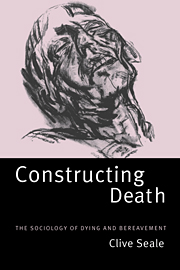2 - Death, embodiment and social structure
Published online by Cambridge University Press: 28 October 2009
Summary
The material end of the body is only roughly congruent with the end of the social self. In extreme old age, or in diseases where mind and personality disintegrate, social death may precede biological death. Ghosts, memories and ancestor worship are examples of the opposite: a social presence outlasting the body. Yet the life and death of the body sets the parameters for these and other events at the level of social relations, so some understanding of the variable ways in which human bodies die is necessary for the sociologist wishing to understand the effects of these on social life. Additionally, social structure influences patterns of illness and death in populations. There is in fact an interaction between social structure, social relations and the body.
This chapter, then, will first describe important variations in the ways in which people die and outline briefly the bodily effects of broad categories of disease which cause death in late modern society. It will be shown that the bodily effects of particular diseases that cause death exercise considerable influence over individuals’ capacity to understand themselves as ‘dying’ and, therefore, to choose particular cultural scripts available for the interpretation of such a role. Moving, then, to a more interpretive and constructionist level of analysis, the chapter then presents an account of pain as a culturally influenced, embodied emotion. Gender differences are then used to show how social structure combines with biology to influence the experience of age and patterns of mortality.
- Type
- Chapter
- Information
- Constructing DeathThe Sociology of Dying and Bereavement, pp. 34 - 49Publisher: Cambridge University PressPrint publication year: 1998



